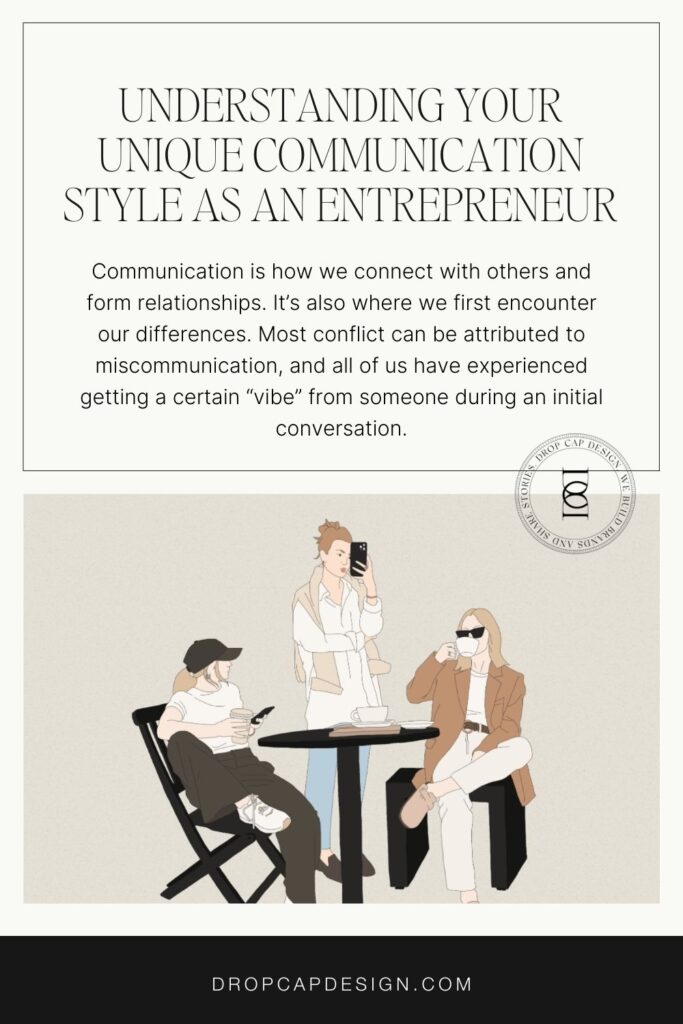I’m always asked how the Enneagram helps you become a better entrepreneur.
While I often point Enneagram newbies towards the growth path and tips for managing stress (who doesn’t want a break from stress?!) I find that the most transformative experiences come through understanding communication styles.
Communication is how we connect with others and form relationships. It’s also where we first encounter our differences.
Most conflict can be attributed to miscommunication, and all of us have experienced getting a certain “vibe” from someone during an initial conversation. So, how does understanding your communication style and the differences between each type help you as a business owner?

Benefits of Understanding Your Communication Style
Self Awareness
First and foremost, understanding your communication style will illuminate behaviors you’re probably unaware of. Little things like talking loudly or too fast, withdrawing from the conversation, overreacting, or coming across too harsh or soft-spoken. While communication “quirks” can sometimes feel individual and random – you’d be surprised how much of it is rooted in your core personality type.
Collaboration
At some point in your business, you’ll want to hire a team, partner with another company, or work alongside a client. Knowing how to respond to opposing points of view, share information, process feedback, and show emotion is vital to healthy collaboration. Building a team requires finding someone you enjoy talking to and working alongside just as much as their ability to get the job done. Just because someone can do the task doesn’t mean you’ll enjoy the process of working with them.
Customer Service
Whether you’re providing a service or offering a product, you’ll eventually have to interact with your audience and customers. Knowing your communication style will help you see what kind of relationship you thrive in – a good thing to know even in the early stages of starting a business and deciding which route to take. Understanding your default communication style can help you build in buffers for triggering conversations, assist you in pitching your offer or making the sale, and even create beautiful long-lasting relationships with your customers that result in great testimonials and, usually, continued work.
Personality-Typing Best Practices
As we explore each of the nine Enneagram types and their unique communication styles, there are a few things to remember about your personality and understanding the personalities of others.
There is no ‘good’ or ‘bad’ personality.
Each personality has certain strengths and weaknesses. When learning about your communication style, understand that we’re all a work in progress, and part of growth is knowing where you need to do the work. Don’t let your personality type keep you from putting yourself out there or building relationships. You will never be a perfect human; you will always need to ask for forgiveness at some point or another.
Do not manipulate your knowledge.
Understanding the potential weaknesses of another personality is not your permission to manipulate the conversation. Telling a Type Nine that if having their own point of view will cause conflict within the group is manipulative. Communicating to a Type Four that you don’t have time for their feelings and to ‘suck it up’ is unkind. Sharing with a Type Three that everyone’s talking about them (in a bad way) is just cruel. Use the information you gather to have more empathy for others’ experiences to create peaceful dynamics.
You are not in a box.
One of my favorite parts of the Enneagram is its fluidity. You are not confined to your type, nor should you fully embody it. The point of this personality model is to shine a light on our instincts so that we can more consciously show up in the world. You have access to every other type in one way or another. Consider developing your Type Two wing to have a more generous, helping heart. Focus on embodying the confidence of a Type Eight next time you give a presentation. Learn from a Type One what it means to stand up for your beliefs. Do not feel confined or limit yourself to being one type of way.
Talk about it.
The best way to understand others is to have a real-life conversation with someone who sees the world differently than you do. What causes a Type Five to want to shut down during a conversation? Ask about it, preferably in a non-personal way that feels safe. Not sure how to respond to a Type Six’s anxious venting sessions? Next time it’s a non-emergency situation, just ask what supports them most in those conversations. Most people ultimately want to feel understood when communicating with you and being asked to clarify shows that you care.

How to Communicate with a…

Type 1 “The Perfectionist”
rational, ethical, critical, practical
A Type One personality is motivated by a desire to be in good standing with others while upholding their personal standards. However, Type Ones may feel irritated when others come up short or don’t do what they say. Usually, this is because they feel pressure to perform at their own highest level and expect others to do the same.
Ones prefer expectations to be clearly communicated, use logical reasoning during discussions, and expect others to take ownership. They are masters of efficiency and can judge a situation fairly.
When under stress, Ones can appear angry and may be nitpicky and critical—know that they are most critical of themselves. When they can complete a project and feel proud of their contribution, they can relax and celebrate a job well-done.
Communication Style: delegating, teaching, preaching, informing, telling, educating, and elevating.
Energy: rigid, upright, stiff, contained, solid, stoic, elegant, polished, self-assured.
Internal Dialogue: I am right; I am good; I know best; I want perfection.
Best Practices: communicate expectations, take ownership, acknowledge a job well done
A Type One wants to communicate to the world that they have it together and are competent, right, and good moral people, even though internally they may feel the opposite.

Type 2 “The Helper”
heartfelt, effusive, helpful, manipulative, people-pleasing
A Type Two personality is motivated by a desire to help others and be seen as accommodating and loveable. However, Twos can sometimes operate with ulterior motives and end up playing the martyr when they feel their efforts for others aren’t recognized.
Twos need to know where they stand in the relationship. They are masters of reading the room and anticipating what needs to be done, but they want to be properly appreciated and acknowledged for their contribution.
When under stress, Twos often become needy and manipulative—giving assistance even when it isn’t being asked of them in order to gain leverage in an uncomfortable situation and in an attempt to repair the relationship.
Just know it’s because they value the relationship’s health above all else. When they know where they stand and feel valued in their role, they are incredible collaborators and can nurture a team’s culture. They also make amazing managers of people.
Communication Style: inviting, relational, heartfelt, emotional, helpful, complimentary, and empathetic.
Energy: soft but strong, seductive, clingy, flirtatious, nurturing, emotional, kind.
Internal Dialogue: I am helpful; I am nice; I am giving; My will be done; I have what you need.
Best Practices: be appreciative, get personal, give credit where credit is due
Type Two wants to be seen as helpful and kind because this supports their self-image. Two’s will present themselves as someone with whatever you need, whether resources or attention.

Type 3 “The Achiever”
successful, goal-oriented, driven, image-conscious
A Type Three personality is motivated by wanting to be seen as the winner and achieve personal & professional milestones. They haven’t seen a challenge they aren’t eager to solve, and will work tirelessly to get to the finish line. However, Threes can be classic narcissists and unaware of their impact on others.
Threes wants conversations to be efficient, future-focused, and know exactly what you’re expecting of them. Threes are visionary, inspiring, and great at setting, and meeting, goals.
When under stress, Threes often come across as arrogant and dismissive. Just know it’s typically a defense mechanism when they feel like they are being evaluated and coming up short or that there’s work to be done and time is limited.
When they feel productive and effective at work, they are inspirational, encouraging, and highly motivational.
Communication Style: strategic, professional, polished, bragging, smooth, trendy, competent, and mentoring.
Energy: tough exterior, shallow, impressive, energetic, high powered, glossy, chameleon, proactive.
Interior Dialogue: I am successful; I am a winner, I am impressive, I will accomplish the goal.
Best Practices: pair criticism with praise, focus on the future, and be efficient with your words
Type Three wants to be seen as someone successful and attractive, so they will present themselves as popular and accomplished even if they feel like an imposter internally.

Type 4 “The Individualist”
creative, intuitive, melancholy, original
Type Four is motivated by a desire to express their inner world and to be different and unique. However, Fours can easily become victims of their emotions.
Fours want to feel that they have the space to fully express their experiences while also feeling heard and supported by those around them. Fours are naturally creative and can develop original ideas for solving problems.
When under stress, Fours may become moody and high maintenance. Just know it’s a way of processing a wide range of emotions that need to be processed in order to move forward. When they feel understood and appreciated, they are insightful, emotionally aware, and grounded.
Communication Style: Breathy, dramatic, metaphorical, vain, symbolic, passionate, discerning.
Energy: Fluid, poised, sensitive, intense, emotionally charged, melancholy.
Interior Dialogue: I am intuitive; I am deep; I am creative; I am different.
Best Practices: be patient, provide support, and communicate emotions surrounding the situation
A Type Four wants to be seen as special and creative and will often exaggerate their differences to cover up feelings of being ordinary or mundane.


Type 5 “The Observer”
cerebral, remote, private, peculiar, intelligent
A Type Five personality is motivated by a desire to intellectually understand the world to feel safe and secure within it. However, Fives can emotionally withdraw and become distant from others when processing a situation or experienc.
Fives must have all the information and space to mentally process before sharing their thoughts. They are masters of analytics and deep thinkers who are wise and discerning in their interactions.
When under stress, Fives may have problems being part of a team, experience social anxiety, and come across as shy or wishdrawn. Just know it’s because they need a moment to process their own thoughts before responding.
When a Five feels safe and independent, they are intelligent, highly inventive, and contribute well-researched and creative ideas.
Communication Style: technical, knowledgeable, unemotional, detached, know it all, specific, distinct.
Energy: prickly, removed, quiet, withdrawn, observant, and independent.
Internal Dialogue: I am knowledgeable; I need more time; I am intelligent; I think; I am different.
Best Practices: give space, provide all the details, remove overly emotional language
Fives want to be seen as intelligent, rational, and idiosyncratic. They may over-share their knowledge to cover feelings of insecurity.

Type 6 “The Loyalist”
witty, reliable, anxious, prepared
Type Six is motivated by a desire to find a trustworthy person in charge so they can feel safe and certain of the future. They are extremely loyal to their community but often experience anxiety about who to trust and whether or not things will turn out ok.
Sixes wants to feel a sense of belonging within a safe and predictable environment. Sixes are reliable, nurturing, and masters of planning the road.
When under stress, Sixes may become overly reactive, letting their anxiety take the wheel. To counter this, focus on teamwork for crisis management and creating a safe space for people to express their thoughts and feelings.
When a Six trusts the group they are a part of and can anticipate what’s down the road, they are extremely loyal, easy collaborators, excellent problem solvers, and supportive friends.
Communication Style: tentative, funny, friendly, warm (or prickly), sarcastic, engaging, rebellious, provocative.
Energy: Mentally active, hyper-vigilant, anxious, suspicious, punchy, and high-strung.
Internal Dialogue: I am clever; I must be safe; I am loyal; I am harmless; I am “real.”
Best Practices: create safety nets, focus on culture, be consistent
Sixes want to be seen as responsible, clever and loyal. They may cover insecurity with ingratiating niceness, sweetness, or rebellious provocativeness.

Type 7 “The Enthusiast”
entertaining, adventurous, versatile, future-focused
Type Seven is motivated by a desire to stay positive and keep things moving to avoid boredom. They constantly make plans for the future and finding something fun and exciting to look forward to. However, Sevens can lack focus when too many opportunities are available or things get hard.
Sevens want conversations to be light, exciting, fast-paced, and positive, with everyone bringing ideas to the table. They are visionary, creative, and can work quickly.
Under stress, Sevens will become inconsistent, high-strung and frantic, and overly indulgent to get a dopamine hit to offset their anxiety. This is a way of avoiding hard conversations or difficult realities when the fun times finally catch up.
When Sevens feel excited for the future, proud of their accomplishments, and connected with their team, they are visionary, grounded, realistic, and able to make significant progress.
Communication Style: High energy, fun-loving, entertaining, storytelling, enthusiastic, evasive, exaggerating, frantic.
Energy: Amped-up, restless, airy and light, quick, spritely, mischievous, fast, positive, shallow.
Internal Dialogue: I am free; I am exciting; I am entertaining; I want it all; I am positive.
Best Practices: keep it light, stay focused, reward progress & see things through to the end
A Type Seven wants to be seen as interesting, entertaining, and fun. They may cover over feelings of inferiority or a fear of being bored with big plans and interesting stories.

Type 8 “The Challenger”
assertive, bold, domineering, powerful, protective
Type Eight is motivated by a desire to control themselves and their environment to avoid being controlled by others. Eights are often the most ethical and nurturing personalities, but at times they can come across as aggressive and strong-willed.
Eights want conversations to be honest, straightforward, and solutions-focused, with everyone taking personal ownership. They are fiercely protective, confident, and effective leaders.
When under stress, Eights can feel harsh, aggressive, and calculating. Often, this is a way to protect their feelings of vulnerability and hurt emotions.
When an Eight finds people to lead, they are strong, nurturing, and inspire the respect and admiration of others.
Communication Style: bold, direct, factual, brash, impactful, empowering, offensive, confident.
Energy: strong, solid, powerful, intimidating, big, respectful, irreverent, crisp, cool.
Internal Dialogue: I am strong; I am a survivor; I am in charge; I will protect.
Best Practices: be honest, hold your ground, take ownership
Type Eight sees themselves as strong and in charge. They want others to recognize their strength and protect against vulnerability, both for themselves and others.

Type 9 “The Peacemaker”
easygoing, relaxed, gentle, stubborn, introverted
A Type Nine is motivated by a desire to maintain inner peace by calming themselves down and creating a serene environment for others. However, can get reactive and become judgmental when pushed into an uncomfortable position.
Nines want conversations to be kind, peaceful, and focused on solutions instead of problems. They are great team players and can see many different points of view.
When under stress, Nines have difficulty caring for themselves and meeting others’ expectations of them. It’s usually a sign that they need encouragement and a pep talk to get back on track. They are motivated, great listeners, and engaged with the world when they feel calm and cared for.
Communication Style: peaceful, agreeable, complacent, stubborn, passive (aggressive), noncommittal, receptive.
Energy: calm, grounded yet spacey, detached, open, sleepy, daydreaming.
Internal Dialogue: I am peaceful; I am calm; I am easy; I am drama free; I am uncomplicated.
Best Practices: be calm, encourage, explain reasoning
A Type Nine wants to be seen as easygoing and peaceful and may deny problems or negative emotions to cover over secret feelings of anxiety or anger.
Save this post for later



Want to discover which communication style suits you?
If you enjoyed this article but want to discover your own Enneagram personality type so you can become a more effective communicator—I’ve created a free ebook to help you find your type!




